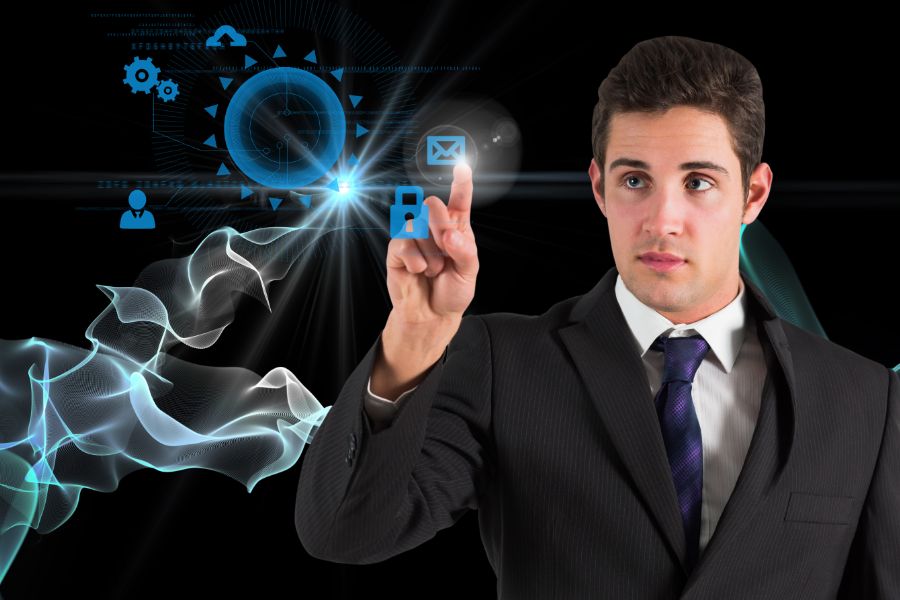In an era marked by technological innovation, businesses are increasingly turning to facial recognition as a transformative tool. From enhancing security measures to streamlining operational processes, this cutting-edge technology holds the promise of reshaping the business landscape. This article delves into “how does facial recognition work?” and how it can be a game-changer for businesses.
What Is Facial Recognition?
Facial recognition constitutes a biometric technology designed to discern and authenticate individuals through the distinctive features of their faces. This process involves the analysis of facial patterns and shapes to generate a unique template known as facial data, enabling the identification of people.
How does facial recognition work when faces are partially obscured in video streams? Facial recognition technology demonstrates its accuracy by effectively identifying individuals even in such conditions.
While the technology is proficient at independently identifying a person based solely on their facial characteristics, it is often integrated with other biometric methods and authentication measures, including fingerprints, Radio Frequency Identification (RFID) cards, or QR codes. This strategic integration enhances security through the implementation of two-factor authentication or multi-factor authentication, providing an additional layer of protection to the identification process.
Types Of Facial Recognition Technology
In 2022, the facial recognition market was valued at approximately five billion U.S. dollars, and projections indicate a substantial growth trajectory, reaching an estimated 19.3 billion U.S. dollars by 2032.
This technology manifests in diverse forms, employing unique methods and approaches for the authentication and identification of individuals. The primary types of facial recognition technology encompass various techniques, all contributing to the evolution of this dynamic market.
- Traditional 2D Facial Recognition: This method captures and analyzes the two-dimensional features of a person’s face, such as the distance between the eyes, nose, and mouth. It is commonly used in photo-based identification systems.
- 3D Facial Recognition: Utilizing depth-sensing technologies, 3D facial recognition creates a three-dimensional model of the face, capturing additional information about facial contours. This enhances accuracy, especially in challenging lighting conditions.
- Infrared Facial Recognition: How does facial recognition work in this case? Infrared technology plays a pivotal role in this process by detecting heat patterns on the face, enabling recognition even in low-light or nighttime conditions.
- Facial Thermography: This type of technology measures the temperature of specific facial regions and is often used for non-intrusive fever screening or health-related applications, such as identifying individuals with elevated body temperatures.
- Facial Recognition with Mask Detection: In response to the COVID-19 pandemic, facial recognition systems have been adapted to recognize individuals even when wearing masks. This involves combining facial features above the mask and other identifiable characteristics.
- Facial Expression Recognition: This technology analyzes facial expressions to determine emotions or moods. It has applications in various fields, including human-computer interaction, market research, and sentiment analysis.
- Deep Learning Facial Recognition: Leveraging artificial intelligence (AI) and deep learning algorithms, this approach enhances accuracy by allowing the system to learn and adapt to different facial features over time. It is particularly effective in handling large datasets.
- Mobile Facial Recognition: Designed for mobile devices, this technology enables facial recognition on smartphones and tablets for tasks such as unlocking devices, mobile payments, and secure access to applications.
- Liveness Detection: To counteract spoofing attempts, liveness detection verifies that the facial recognition system interacts with a live person rather than a static image or video. This improves the security of facial recognition applications.
Understanding the diverse types of facial recognition technology is crucial for selecting the most suitable solution based on specific needs and use cases.
How Does Facial Recognition Work?
The facial recognition process comprises four essential stages: face detection, facial feature extraction, face verification/identification, and decision-making. Notably, Notably, ConnectPOS integrates with facial recognition cameras and software, enabling businesses to effortlessly identify shoppers, link purchase history, and generate personalized product recommendations based on real-time data.
Let’s delve into the intricacies of each of the steps on how facial recognition works:
Face Detection
The facial recognition process commences with face detection, involving the identification and localization of a human face in an image or video. Specialized face recognition software employs algorithms to recognize key facial features, marking them for subsequent identification.
Various techniques are employed for face detection, including the Viola-Jones algorithm, Histogram of Oriented Gradients (HOG), Support Vector Machine (SVMs), and Deep Learning. The Viola-Jones algorithm, leveraging Haar cascades, is particularly popular for detecting faces in images or videos.
Facial Feature Extraction
How does facial recognition work in the process of facial feature extraction? Once a face is identified, facial feature extraction comes into play, aiming to extract crucial features from the face. A facial recognition algorithm and software identify key points on the face, such as eyes, nose, mouth, etc. These features contribute to creating a unique facial map, facilitating further analysis and biometric identification.
Face Verification
With the facial feature map established, it undergoes a comparison with existing facial maps in a database. Biometric facial recognition algorithms then determine whether the face matches any existing maps, enabling verification (1:1) or identification (1:N). Approaches for facial verification include Holistic Matching, Local Feature Analysis (LFA), and Elastic Bunch Graph Matching (EBGM), among others.
Decision-Making
How does facial recognition work in the decision-making process? Following the determination of the presence or absence of a face by the facial recognition algorithm, it proceeds to make informed decisions based on the information obtained. This could involve granting or denying access, displaying relevant user information, and more.
Additionally, integrating Face Liveness Detection is imperative for spoofing prevention in the facial recognition process. This technology confirms the vitality of the person in front of the camera, distinguishing them from images, masks, or videos.
Algorithms scrutinize facial features such as eye blinking, head movement, and facial expressions, actively countering spoofing attempts and ensuring the ongoing safety of the security system.
The 5 Applications Of Facial Recognition
Facial recognition technology finds diverse applications across various sectors, showcasing its versatility and effectiveness. Here are five notable applications:
Retail
In retail settings, face recognition systems play a crucial role by identifying VIP customers, monitoring in-store traffic, and providing insights into customer behavior. This technology proves advantageous for retailers as it enables the swift identification of individuals with a history of theft, effectively reducing instances of theft.
Additionally, retailers can further enhance their operational efficiency when incorporating the multi-store management feature. This feature allows businesses to centrally manage and coordinate facial recognition data across multiple store locations.
Mobile Authentication
Facial recognition has become a cornerstone of mobile security, surpassing traditional methods such as PINs or passcodes. Notably, Apple’s Face ID exemplifies the widespread adoption of mobile face recognition. How does facial recognition work? This technology enhances security measures, enabling secure authentication for payment protection and app authorization on mobile devices.
Healthcare
Healthcare organizations are increasingly adopting facial recognition technology to accurately identify patients and verify their information during access to healthcare services. This application streamlines processes, allowing for quick patient identification and confirmation of their identity, thereby enhancing efficiency and maintaining the security of medical records.
Physical Access Control
Beyond healthcare, facial recognition is employed for physical access control in various industries. It serves as an efficient means to identify individuals and confirm their identity, enhancing overall security while streamlining access processes. This is particularly valuable in secure environments where controlled access is crucial.
Border Control
Facial recognition provides a reliable authentication method for travelers at borders, ensuring that only authorized individuals can enter a country. Self-service kiosks equipped with facial recognition have gained popularity in airports, enhancing the passenger experience. This technology reduces reliance on human labor and maintains high-security standards, contributing to efficient border control measures.
The Top 5 Benefits Of Facial Recognition
Facial recognition technology presents numerous advantages for both businesses and consumers, revolutionizing various industries with its diverse benefits. The key advantages of facial recognition technology include:
Increased Security
While numerous biometric methods enhance security, facial recognition stands out for its non-intrusive nature and long-distance operation. Unlike proximity methods like fingerprints or iris scans, facial recognition excels in identifying individuals from a distance, making it ideal for crowd monitoring and real-time threat detection. With the integration of AI, these systems can proactively detect anomalies, offering advanced security measures.
How does facial recognition work in this case? The swift scanning and cross-referencing of databases enable instant identification of potential security threats, making it a preferred choice for modern surveillance systems. AI-driven facial recognition CCTV surveillance systems provide powerful 24/7 monitoring, and real-time threat detection, and deter criminal activity.
Moreover, when combined with other authentication methods, facial recognition adds an extra layer of security to both online and physical transactions.
Advanced Touchless Experiences
Advanced touchless experiences are a defining aspect of facial recognition technology. In a world prioritizing hygiene and swift interactions, the capability to authenticate or grant access without physical contact is invaluable. This touchless feature is particularly crucial in high-traffic locations like airports or public transport stations, where speed and efficiency are paramount.
Facial recognition’s touchless nature stands out, enabling seamless processes for accessing buildings, verifying identities in transactions, or boarding flights without requiring physical contact or specific actions.
Moreover, when integrated with customer relationship management (CRM) systems and loyalty programs, facial recognition technology adds another layer of value. By linking facial data with customer profiles, businesses can personalize interactions, streamline transactions, and enhance loyalty programs based on individual preferences
Personalized Customer Experience
Facial recognition extends beyond basic identification by analyzing facial expressions and emotions. This technology allows businesses to assess customer reactions in real time, enabling the provision of personalized services or promotions based on mood or engagement level. That is the way facial recognition works to improve customer experience.
Integrating clienteling practices with facial recognition adds another layer to this personalized approach. By combining facial analysis with customer data and preferences, businesses can engage in clienteling strategies that involve creating tailored experiences, building stronger customer relationships, and anticipating individual needs based on both facial expressions and historical data.
Operational Efficiency
Facial recognition’s quick processing and identification of individuals in large crowds set it apart. In events or large workplaces, the system swiftly checks and verifies individuals, streamlining entry processes. Integration with AI allows the automation of tasks like sentiment analysis during feedback sessions or optimizing customer interactions based on recognized preferences.
Moreover, the multi-store management ability amplifies the advantages of facial recognition technology. This capability allows seamless coordination and central control of facial recognition data across multiple store locations. With this integrated approach, businesses can ensure a consistent and efficient application of facial recognition for security and personalized customer experiences across their diverse network of stores.
Increased Convenience
Facial recognition contributes significantly to convenience for both businesses and customers. Its adaptability is evident in its ability to recognize individuals, even wearing masks—a crucial advancement driven by global events. Unlike other biometrics that may require specific conditions, facial recognition seamlessly integrates into various scenarios.
Whether providing quick access at security checkpoints, enabling instant personalization in retail, or facilitating swift authentication for online services, the technology minimizes wait times and enhances user experience. Continuous improvements ensure reliability and consistency, even as facial features evolve due to style changes or temporary accessories.
These top five benefits underscore “how does facial recognition work to enhance security, provide personalized experiences, streamline operations, and maximize convenience for businesses and consumers across diverse industries?”
Conclusion
As businesses navigate the complexities of the modern landscape, integrating facial recognition emerges as a strategic move with far-reaching implications. Embracing “how does facial recognition work?” can position businesses at the forefront of innovation, fostering a more secure, efficient, and customer-centric environment that adapts seamlessly to the evolving demands of the digital age.
If you are interested in learning more about how facial recognition can transform your business, ConnectPOS can offer one-stop solution by integrating with your required providers. Please feel free to contact us today. We would love to hear from you and answer any questions you may have.
ConnectPOS is a all-in-one point of sale solution tailored to meet your eCommerce POS needs, streamline business operations, boost sales, and enhance customer experience in diverse industries. We offer custom POS with features, pricing, and plans to suit your unique business requirements.




